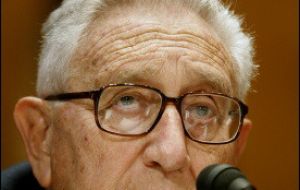MercoPress. South Atlantic News Agency
Released documents reveal Brazil’s crucial role in 1973 Chilean coup
 Henry Kissinger, was named “unofficial” direct contact between then President Nixon and Brazilian dictator Emilio Garrastazú Medici.
Henry Kissinger, was named “unofficial” direct contact between then President Nixon and Brazilian dictator Emilio Garrastazú Medici. Former Brazilian dictator Emilio Garrastazú Médici and ex US president Richard Nixon agreed on the need to oust Chilean peer Salvador Allende and Cuba’s Fidel Castro during a meeting at the White house in 1971, when then advisor Henry Kissinger wrote the minutes, according to declassified documents published Sunday.
General Garrastazú Medici said Brazil was working towards the overthrow of President Allende during the meeting at the Oval Office on December 9, 1971, according to a report published Sunday the Folha do Sao Paulo based on a batch of records concerning US-Brazil collaboration in opposing left-leaning governments in Latin America in the early 1970s, posted Saturday on the National Security Archive website.
Nixon asked Garrastazú Medici (1969/1974) if the Chilean military were prepared to collaborate in the overthrow of the Socialist democratically elected Allende. The Brazilian general replied that Allende would be ousted for the same reasons that led to the coup against constitutional president Joao Goulart back in 1964.
The Goulart family has a demand against the US government for their complicity in the coup which established in Brazil a military dictatorship that lasted unit 1984. According to the children and Goulart’s wife, in 1964 US Ambassador Lincoln Gordon and military attaché Vernon Walters participated actively in the ousting of the constitutional president.
Goulart took refuge in neighbouring Uruguay and was later allegedly poisoned in Argentina, in 1976, when informal talks for a return to civilian rule in Brazil had begun with some of the less radical military.
Vernon Walters, a polyglot, had close contacts with the Brazilian military: he had been the liaison between the Brazilian expeditionary forces fighting next to US forces in Italy during Second World War II. The promotions of young Brazilian officers who fought in Italy were later involved in the 1964 coup.
Henry Kissinger, Nixon’s national security advisor and only known survivor of the 1971 meeting wrote the minutes and the report recently released to public opinion
“The president said that it was very important that Brazil and the United States work closely in this field. . . . If money were required or other discreet aid, we might be able to make it available,“ stated the synopsis of the conversation. “We must try and prevent new Allendes and Castros and try where possible to reverse these trends” Nixon added in the Kissinger drafted summary.
Nixon said he would support a Cuban exile effort to overthrow Castro “as long as we did not push them into doing something we could not support, and as long as our hand did not appear”.
The offer of US help came after Garrastazú Medici told Nixon that Brazilian military officers were working with counterparts in Chile and that he thought Chilean armed forces were capable of overthrowing Allende. At the time Brazilian intelligence was also monitoring Brazilian exiles in Chile.
Two years after the meeting in Washington the Chilean military under the command of General Augusto Pinochet overthrew Allende in a bloody coup in September 11, 1973. The military regime lasted until 1990.
Nixon and Garrastazú Medici not only agreed on the need to support anti-Castro Cuban exiles but also to counter efforts from other Latinamerican countries to have Cuba return to the Organization of American States, OAS.
Peru at the time ruled by nationalist allegedly left leaning military under General Velazco Alvarado was at the head on an international movement in favour of Cuba’s reincorporation to OAS. Nixon and Garrastazú Medici mulled manipulating the president of Peru by leaking word of his affair and child with a former Miss Peru.
The two presidents agreed to communicate directly outside regular diplomatic channels. Henry Kissinger was designated as Nixon's contact with Garrastazú Medici for back channel conversations.
However the declassified documents did not surprise political scientists or Brazilian diplomats. Jair Krischke, one of the most respected experts on the Brazilian dictatorship (1964/1985) said Brazil was “crucial” for the US strategy of “destabilization” in the Southern Cone from the end of the sixties, “when intelligence agents and torture experts started to be sent to the region”.
“The documents open the door on a new, untold history of efforts to overthrow Allende” said Peter Kornbluh, US director of the archive's Cuba and Chile documentation projects. “Very few details about Brazil's role have surfaced”.
“There's a paper trail on that yet to be unearthed” that could shed more light on US and Brazilian efforts at regional regime destabilization, added Kornbluh.
Historian Robert Dallek, author of “Nixon and Kissinger” said cultivation of Garrastazú Medici fits Nixon and Kissinger's pattern of recruiting conservative heads of state to the US Cold War cause. But Brazil's role “is not widely known,” Dallek said. “It's fresh detail.”
Roberto Abdenur, former Brazilian ambassador in Washington the revelations come as no surprise since ”what Nixon and Garrastazú Medici did was seal at the highest level an organized collaboration in what both were completely committed and convinced”.




Top Comments
Disclaimer & comment rulesCommenting for this story is now closed.
If you have a Facebook account, become a fan and comment on our Facebook Page!